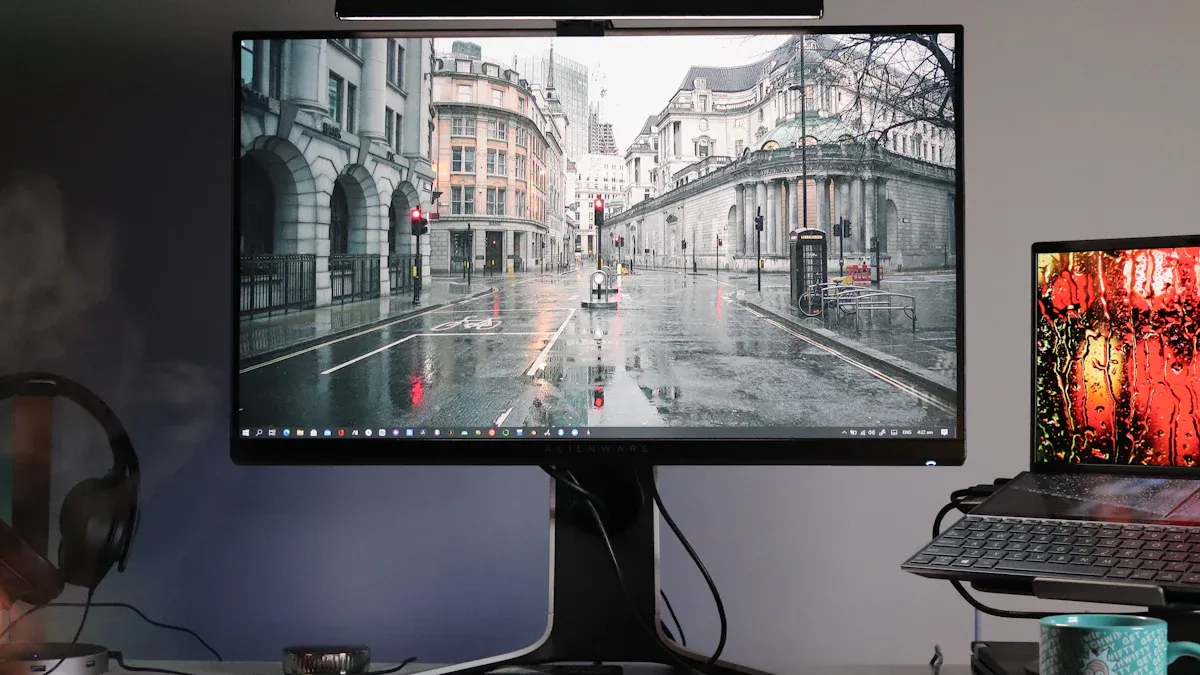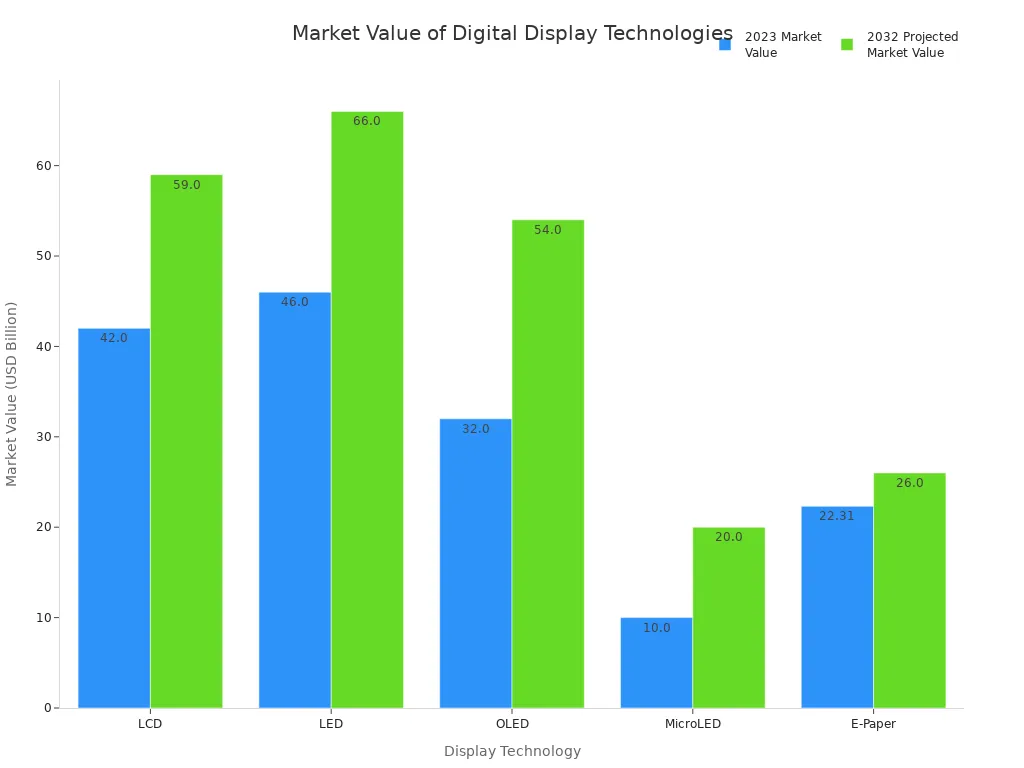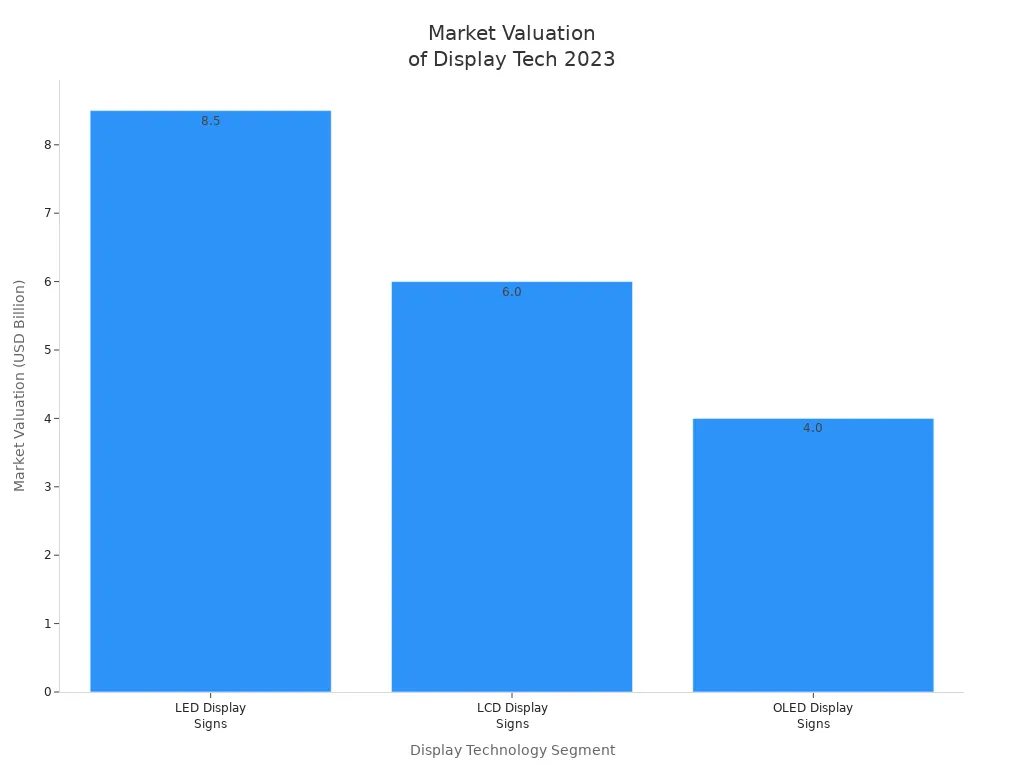A Beginner’s Guide to Display Technology

Display technology refers to the electronic methods used to visually present information on screens in devices like smartphones and televisions. Two main categories exist: self-emissive displays, which produce their own light, and light-inducing or reflective displays, which rely on external light sources. In daily life, consumers interact with display technology constantly, from vibrant OLED screens on new smartphones to LCD panels in tablets and TVs.
The adoption of advanced display technology continues to accelerate. For example, over 60% of new smartphones now feature OLED panels, and LCD remains a staple in smart devices.
Aspect | 2024 Value/Share |
|---|---|
OLED in new smartphones | Over 60% adoption |
LCD market value |
Data source: OLED Display Market Report(2024)
Key Takeaways
Display technology includes self-emissive screens like OLED and Micro LED that produce their own light, and light-inducing displays like LCD that use backlights or ambient light.
Self-emissive displays offer deep blacks, vibrant colors, and fast response times, making them ideal for premium TVs, smartphones, and gaming.
Light-inducing displays like LCDs are energy efficient, cost-effective, and widely used in TVs, monitors, and e-readers with good readability in bright environments.
Emerging technologies such as flexible, transparent, and 3D displays are expanding how we interact with screens in devices like wearables and automotive displays.
Choosing the right display depends on factors like resolution, refresh rate, color accuracy, and environment, helping users find the best screen for gaming, work, or outdoor use.
What Is Display Technology?
Definition and Purpose
Display technology refers to the collection of methods and technologies used to generate visual output on screens. This includes devices such as televisions, monitors, and smartphones. In modern life, display technology serves as the primary output device, presenting information visually or tactilely. Users interact with images, videos, and data through these screens every day. The purpose of display technology centers on enabling clear communication and efficient information delivery.
Digital displays present multimedia formats, making them powerful communication tools. Businesses use digital signage to engage customers and employees. Real-time, dynamic information delivery sets digital displays apart from static posters or notice boards. Key types of display technology include LCDs, LEDs, plasma, and E-Ink. Each type offers unique advantages for specific applications, such as high brightness for outdoor use or low power consumption for e-readers.
Evolution of Flat-Panel Display
The journey from bulky cathode ray tube (CRT) displays to modern flat-panel display technology marks a significant transformation in the electronics industry. CRT displays, invented in the early 20th century, used electron beams to illuminate phosphors. These displays provided excellent color and contrast but were heavy and consumed significant power.
Flat-panel displays began to emerge in the late 1980s and early 1990s. The first flat-panel technology, plasma display panels, used arrays of tiny neon lights to create high-contrast images with fast response times. Despite their strengths, plasma displays remained heavy and fragile. The introduction of LCDs marked a turning point. LCDs offered slim designs and energy efficiency, quickly gaining popularity for televisions, monitors, and portable devices.
The LED revolution improved flat-panel displays by replacing traditional backlights with LEDs, enhancing brightness and color accuracy. OLED technology followed, using organic compounds to emit light per pixel. This advancement enabled true blacks, infinite contrast, and superior viewing angles.
Metric | Flat Panel Displays (FPD) | CRT Displays |
|---|---|---|
Market Size (2023) | ~50 million units | |
Annual Growth Rate | 5-7% (growth) | Declining, shrinking by ~5 million units annually |
Market Value (2025 estimate) | $100 billion, projected to grow to $140 billion by 2033 | Declining due to obsolescence |
Data source: Flat Panels & CRT Displays in Developing Economies: Trends and Growth Analysis 2025-2033
Flat-panel displays now dominate the global market. Technological advancements, demand for high-resolution screens, and consumer electronics expansion drive this growth. The shift from CRT to flat-panel displays reflects a clear trend toward lighter, more energy-efficient, and versatile display solutions.
Types of Display Technology

Display technology has evolved rapidly, offering a diverse range of solutions for different needs. Understanding the main types of display technology helps users make informed choices for devices such as TVs, monitors, smartphones, and specialized equipment. The following sections break down the most important categories: self-emissive displays, light-inducing and reflective displays, and emerging digital display technologies.
Self-Emissive Displays
Self-emissive displays generate their own light at the pixel level. This category includes OLED, Micro LED, QLED, and plasma technologies. Each pixel emits light independently, eliminating the need for a separate backlight. This design enables deep blacks, high contrast, and vibrant color space coverage.
Display Technology Type | Description | Light Generation Mechanism |
|---|---|---|
OLED (Organic Light Emitting Diode) | Uses organic semiconductor materials that emit light when an electrical current passes through. No backlight needed. | Electrons and holes recombine in the organic emissive layer, releasing energy as photons (electroluminescence). |
Micro LED | Employs microscopic inorganic LEDs for each pixel, offering high brightness and energy efficiency. | Each pixel is a tiny LED that emits light directly through electroluminescence. |
QLED (Quantum Dot LED) | Utilizes quantum dots to enhance color and brightness, typically paired with an LED backlight. | Quantum dots convert blue LED light into pure red and green, expanding the color space. |
Plasma (PDP) | Relies on electrically charged ionized gases (plasma) to produce light. | Gas cells emit ultraviolet light, which excites phosphors to create visible colors. |
OLED panels deliver perfect blacks and infinite contrast by turning off individual pixels. Micro LED technology pushes brightness and durability even further, making it suitable for large flat-panel displays and digital signage. QLED displays, with their quantum dot layers, achieve a wider color space and higher brightness, especially in large-screen TVs.
Self-emissive displays excel in applications demanding high image quality, wide viewing angles, and fast response times. OLED dominates premium smartphones and high-end TVs. Micro LED is emerging in commercial displays and luxury home theaters. QLED has gained popularity in mainstream flat-panel TVs due to its cost-effectiveness and robust performance.
Key Advantages
Perfect blacks and infinite contrast (OLED, Micro LED)
Wide color space and high brightness (QLED, Micro LED)
Fast response times, ideal for gaming and video
Wide viewing angles
Typical Applications
Premium TVs and monitors
Smartphones and tablets
Digital signage and large-scale displays
Professional video production
Light-Inducing and Reflective Displays
Light-inducing and reflective displays require external light sources or ambient light to function. This group includes LCD, TFT-LCD, TN, IPS, VA, DLP, and EPD technologies. These displays often use various types of backlight, such as LED arrays, to illuminate the screen. Local dimming, a technique that adjusts the brightness of specific screen zones, enhances contrast and energy efficiency in many flat-panel LCDs.
Display Technology | Technical Principle | Illumination Mechanism | Typical Applications |
|---|---|---|---|
LCD (Liquid Crystal Display) | Liquid crystals modulate light passage under electric fields. | Backlight or reflective surface | TVs, monitors, laptops |
TFT-LCD (Thin-Film Transistor LCD) | Thin-film transistors control individual pixels for higher resolution. | LED backlight with local dimming | Smartphones, tablets, monitors |
TN-LCD (Twisted Nematic LCD) | Twisted liquid crystals switch rapidly for fast response. | LED backlight | Entry-level monitors, gaming screens |
IPS-LCD (In-Plane Switching LCD) | Liquid crystals align horizontally for better color space and viewing angles. | LED backlight with advanced local dimming | Professional monitors, smartphones |
VA-LCD (Vertical Alignment LCD) | Vertically aligned crystals offer deeper blacks and higher contrast. | LED backlight | TVs, business monitors |
DLP (Digital Light Processing) | Micro-mirrors reflect light to form images. | Lamp or LED light source | Projectors, cinema displays |
EPD (Electrophoretic Display, E-Paper) | Charged particles move in microcapsules to display images. | Reflects ambient light | E-readers, outdoor signage |
Note: Local dimming improves contrast by dimming dark areas and brightening highlights. Types of local dimming include edge-lit and full-array, each offering different levels of precision.
Light-inducing displays remain the backbone of mainstream flat-panel devices. LCD and TFT-LCD panels dominate consumer electronics, offering affordability and versatility. IPS-LCD panels provide superior color space accuracy and wide viewing angles, making them popular in professional and creative industries. EPD technology, known for its paper-like readability and ultra-low power consumption, powers e-readers and digital signage.
Key Advantages
High energy efficiency (especially with local dimming)
Wide range of sizes and resolutions
Excellent readability in bright environments (EPD)
Cost-effective for mass production
Typical Applications
TVs, monitors, laptops
Automotive instrument clusters and head-up displays
E-readers and outdoor signage
Industrial and medical equipment
Other Digital Display Technology
The display technology landscape continues to expand with emerging and niche solutions. Flexible and foldable displays, transparent screens, and 3D or holographic displays are reshaping user experiences across industries. These innovations address specialized needs, such as unique form factors, immersive visuals, and advanced interactivity.

Data source: Electronic Display Market Research Report
The market for flat-panel displays continues to grow, driven by demand for higher resolution, energy efficiency, and flexible form factors. Innovations in color space, local dimming, and types of backlight contribute to the expanding capabilities of modern displays.
Emerging technologies like polymer-dispersed liquid crystals and electrowetting displays target improvements in energy consumption, brightness, and sunlight readability. Medical-grade displays, regulated for accuracy and consistency, support critical applications in healthcare and scientific research.
Key Advantages
Enhanced flexibility and new form factors
Superior color space and brightness in advanced displays
Specialized features for medical, automotive, and industrial use
Typical Applications
Wearable devices and foldable smartphones
Retail and automotive displays
Medical imaging and diagnostics
Outdoor and specialty signage
Comparing Display Technologies
Image Quality and Color
Image quality and color accuracy remain critical factors when evaluating modern screens. Objective metrics such as HDR-VDP-2, MS-SSIM, and JND_st help quantify image quality, while color difference formulas like CIEDE2000 and CIE94 assess color accuracy. Industry standards, including IEC 61966-2-1 for sRGB and the International Committee for Display Metrology’s IDMS, ensure consistent measurement across devices.
Display Technology | Contrast Ratio | Color Gamut (NTSC %) |
|---|---|---|
LCD | 75% | |
OLED | 10,000:1 | 124% |
Micro-LED | 1,000,000:1 | 140% |
Micro-LED displays achieve the widest color space and highest contrast ratio. OLED panels also deliver superior color space coverage and deep blacks. LCDs, while cost-effective, offer a narrower color space and lower contrast due to their reliance on backlights and color filters.
Refresh Rate and Response Time
Refresh rate and response time directly impact the clarity of fast-moving visuals. OLED panels support refresh rates up to 120 Hz and response times as low as 0.1 ms, minimizing motion blur. LCDs typically operate at 60 Hz, with gaming models reaching up to 540 Hz and response times between 1–8 ms. QLED displays, a type of LED-backlit LCD, offer refresh rates up to 120 Hz and response times from 2–10 ms. High refresh rates and low response times provide smoother gameplay and video playback, especially in competitive gaming. Technologies like local dimming further enhance visual performance by improving contrast and reducing halo effects.
Energy Efficiency and Lifespan
Energy efficiency and lifespan influence both operational costs and sustainability. LED-based displays consume less power than older technologies, reducing electricity bills by up to 75%. Lifespans can reach 100,000 hours, minimizing maintenance and replacement needs. Local dimming contributes to energy savings by adjusting brightness only where needed. These factors combine to lower the total cost of ownership and support environmental goals.
Pros and Cons Table
Display Technology | Pros | Cons | Typical Applications |
|---|---|---|---|
LCD | Affordable, energy efficient, wide range of sizes | Limited color space, lower contrast | Monitors, TVs, laptops |
OLED | Excellent color space, deep blacks, fast response | Higher cost | Smartphones, high-end TVs |
Micro-LED | Superior color space, high brightness, long lifespan | Expensive, complex manufacturing | Premium displays, signage |
QLED | High brightness, wide color space, energy efficient | Relies on backlight, contrast lower than OLED | TVs, monitors |
E-Paper | Ultra-low power, paper-like readability | Limited color space, slow refresh | E-readers, signage |
Tip: Consider the importance of color space, refresh rate, and energy efficiency when selecting a display for specific applications.
Applications of Digital Display Technology

TVs and Home Entertainment
Televisions and home entertainment systems rely on advanced digital display technology to deliver immersive viewing experiences. LCD and OLED panels dominate this sector. LCD TVs, especially those with LED backlighting, provide bright images and suit well-lit rooms. OLED TVs excel in image quality, offering perfect blacks and fast response times. QLED displays combine quantum dot enhancements with LED backlights, producing vibrant colors and high brightness. The table below compares these leading technologies:
Feature | LED-backlit LCD | OLED | QLED |
|---|---|---|---|
Black Levels | Improved | Perfect blacks | Very good |
Brightness | Very good | Good | Excellent |
Color Accuracy | Very good | Excellent | Excellent |
Viewing Angles | Good | Excellent | Very good |
Response Time | Good | Excellent | Very good |
Lifespan | Very good | Good | Very good |
Power Efficiency | Very good | Excellent | Good |
Cost | Medium | High | Medium-High |
Best Use Case | Affordable, energy efficient | Premium image quality | Bright room viewing |
Smartphones and Tablets
Smartphones and tablets demand displays that balance durability, efficiency, and visual performance. Manufacturers use LCD, OLED, MicroLED, MiniLED, and E-Ink panels. Key requirements include resistance to drops and scratches, long battery life, and support for software upgrades. Continuous innovation in digital display technology drives improvements in energy efficiency and repairability. Devices often display energy ratings and repairability scores, helping users make informed choices.
Main display technologies: LCD, OLED, MicroLED, MiniLED, E-Ink
Performance needs: durability, battery longevity, repairability, upgrade support
Signage and Automotive
Digital signage technology transforms public spaces and vehicles. Automotive dashboards use OLED, LED, Micro-LED, and LCD panels for heads-up displays, instrument clusters, and infotainment systems. Public signage, including billboards and kiosks, relies on LED, direct-view LED, OLED, and LCD for high visibility and energy efficiency. Dot matrix displays enhance real-time data delivery in transit systems. The chart below shows the 2023 market valuation for key signage technologies:

Data source: Electronic Display Sign Market Research Report By Type(2025)
Digital signage technology enables dynamic advertising, interactive wayfinding, and smart city solutions. Integration with IoT and remote management systems supports real-time updates and content control.
Medical and Specialized Uses
Healthcare and specialized industries require displays with high resolution, accuracy, and reliability. Medical-grade LCDs, often calibrated to DICOM standards, support diagnostic imaging in radiology, ultrasound, and surgery. Touchscreen displays enable interactive device control and patient check-ins. Portable and wireless screens facilitate telemedicine and remote care. E-paper displays offer low-power, high-contrast solutions for clinical settings. Compliance with strict medical standards ensures safety and performance in demanding environments.
Medical-grade LCDs: HD/4K resolution, DICOM calibration, anti-glare coatings
Touchscreens: resistive, optical, capacitive for device control
E-paper: low power, high contrast for clinical use
Choosing the Right Display
Key Factors to Consider
Selecting the right display involves evaluating several essential factors. Each user scenario—gaming, reading, professional work, or outdoor use—demands a unique set of priorities. Understanding these priorities helps users make informed decisions.
Resolution and Screen Size: Higher resolutions, such as 1440p or 4K, deliver sharper images and more workspace. Larger screens enhance immersion for gaming and productivity, while moderate sizes suit reading and general use.
Refresh Rate and Response Time: Fast refresh rates (120Hz, 144Hz, or higher) and low response times reduce motion blur, which is crucial for gaming and fast-paced video. Standard refresh rates (60Hz) suffice for reading and office tasks.
Color Accuracy and Gamut: Wide color gamuts and accurate color reproduction benefit creative professionals and gamers who value vibrant visuals. Hardware calibration ensures consistency for design and editing.
Ergonomics and Eye Care: Features such as blue light filters, flicker-free screens, and adjustable stands reduce eye strain during extended use. These features are especially important for reading and professional environments.
Connectivity: Multiple ports support gaming peripherals and professional accessories. USB-C and docking options add versatility for modern workstations.
Ambient Light and Viewing Distance: Bright environments require displays with higher brightness levels to prevent washed-out images. Viewing distance influences the ideal screen size and resolution; closer distances benefit from higher pixel density.
Durability and Environmental Factors: Outdoor displays must withstand sunlight, temperature changes, and dust. Proper ventilation and regular cleaning maintain performance and longevity.
Tip: Consider the room’s lighting and your typical viewing distance when choosing a display. High brightness and anti-glare features improve visibility in sunlit spaces, while higher resolution benefits close-up work.
Understanding the basics of display technology enables consumers to make informed choices in a rapidly changing market. Each display type offers unique strengths:
Display Technology | Key Benefits for Consumers | Considerations |
|---|---|---|
LCD | Cost-effective, widely available | Lower contrast |
OLED/AMOLED | Deep blacks, vivid colors | Lifespan, potential burn-in |
LED/QLED | High brightness, energy efficiency | Contrast limited by backlight |
Plasma | Broad color spectrum | Higher energy use |
Selecting the right display depends on image quality, energy use, and application needs. By comparing features and matching them to specific uses, beginners can confidently navigate display options and embrace new technology with ease.
FAQ
What is the difference between OLED and LCD displays?
OLED displays use organic materials that emit light directly from each pixel. LCD displays rely on a backlight that shines through liquid crystals. OLED provides deeper blacks and higher contrast. LCD offers cost efficiency and broad availability.
How does local dimming improve image quality?
Local dimming adjusts the brightness of specific screen areas. This technique enhances contrast by making dark scenes darker and bright scenes brighter. Viewers experience improved image depth and clarity, especially when watching movies or playing games.
Which display technology is best for outdoor use?
E-paper and high-brightness LED displays perform well outdoors. E-paper reflects ambient light, reducing glare and improving readability. High-brightness LED displays maintain visibility in direct sunlight. Both options support digital signage and public information systems.
What are the current display technology trends?
Manufacturers focus on higher resolutions, flexible screens, and energy efficiency. Mini LED and Micro LED displays gain popularity. Transparent and foldable displays emerge in new devices. These display technology trends shape the next generation of consumer electronics.
How will the future of display technology impact daily life?
The future of display technology promises more immersive experiences, smarter devices, and improved energy savings. Users will see advancements in augmented reality, wearable displays, and seamless integration into everyday environments.
See Also
Understanding The Function And Importance Of LCD Technology
An Introduction To UB Cell Display Technology Explained
Key Features To Consider For The Best Gaming Display